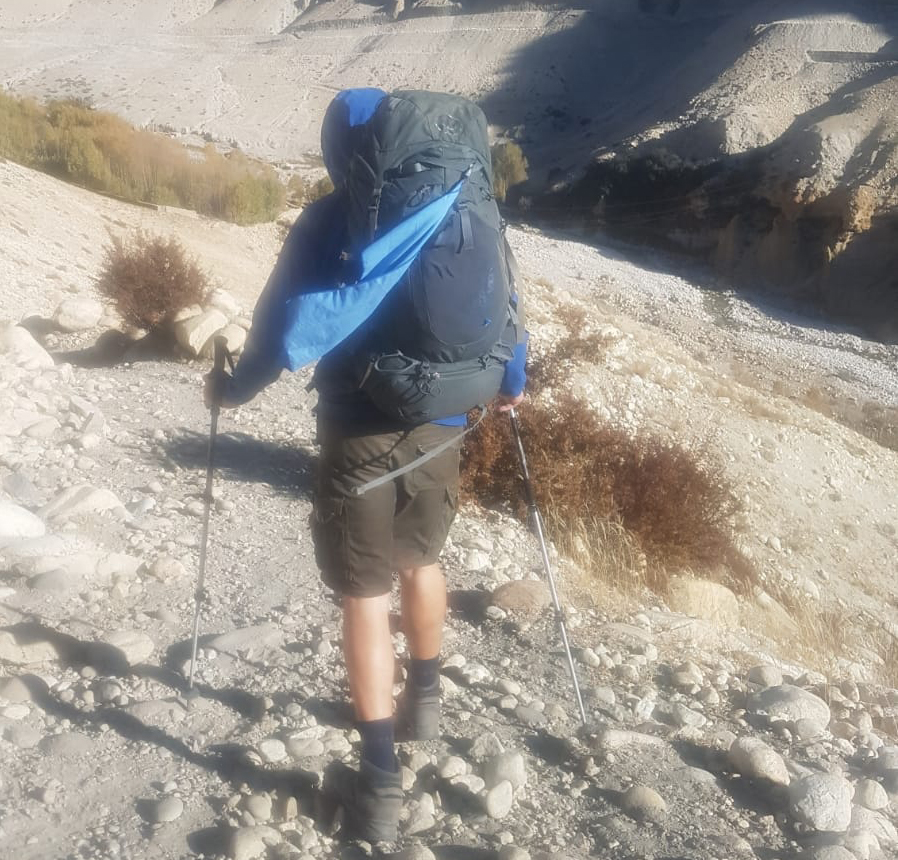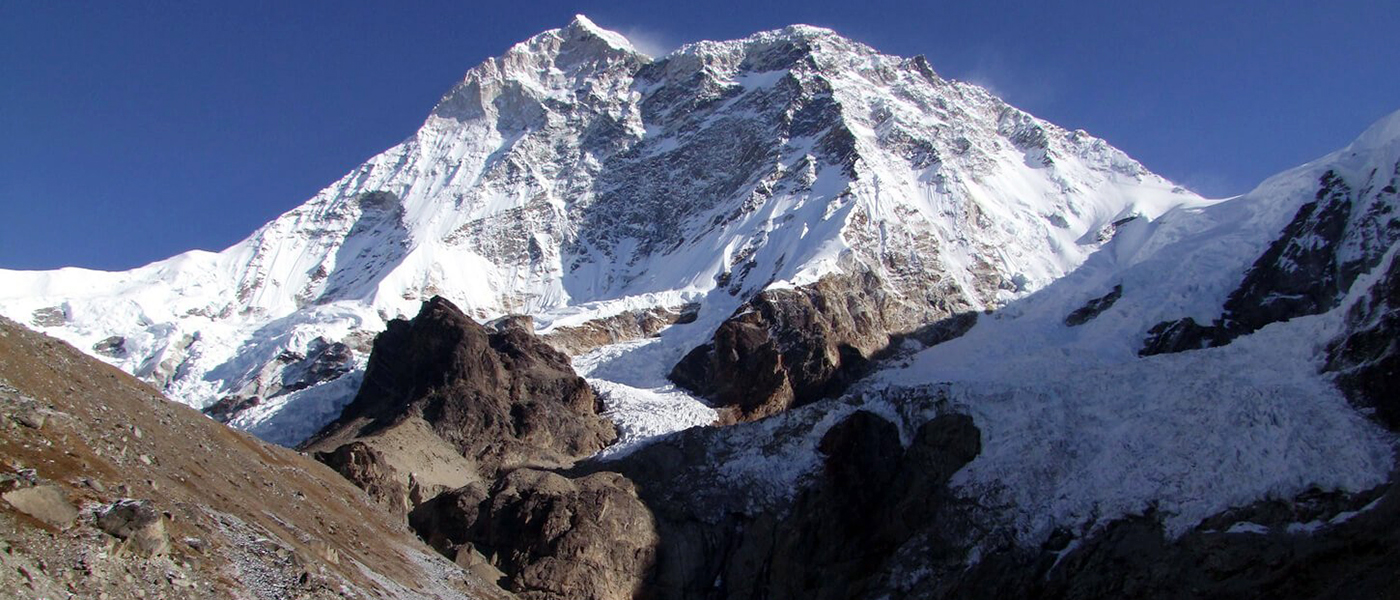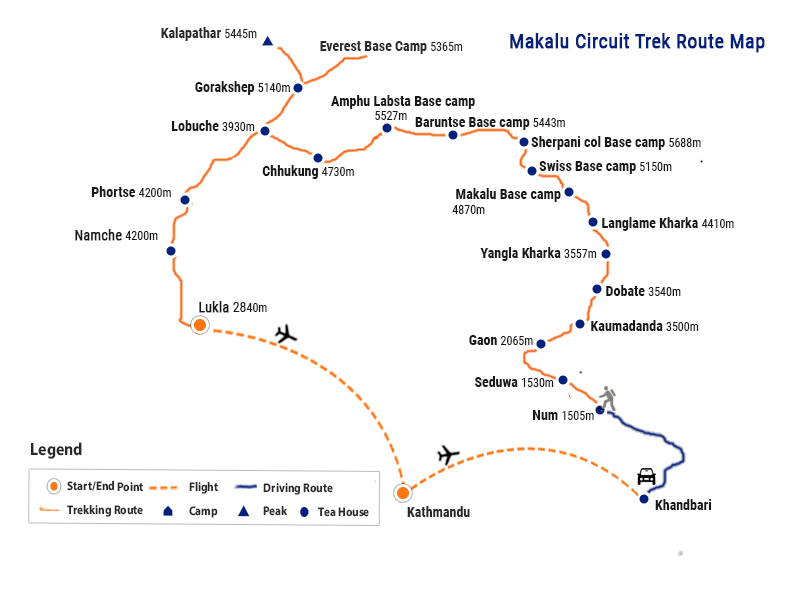Makalu Base Camp Trek
Makalu Base Camp Trek is a challenging and off-the-beaten-path trekking adventure in the eastern region of Nepal. The trek takes you to the base camp of Makalu, the fifth-highest mountain in the world, at an altitude of 4870 meters above sea level. From here, the trekking trail follows the Arun River and passes through beautiful forests, traditional villages, and stunning landscapes. The route is less frequent by trekkers, making it a perfect destination for those who are seeking solitude and tranquility amidst the beauty of nature.
The trail is strenuous and requires physical fitness, as well as previous trekking experience. The highlight of the trek is the spectacular view of Makalu and its neighboring peaks, including Everest, Lhotse, and Baruntse. You will also get to witness the unique culture and lifestyle of the local communities, such as the Sherpa, Rai, and Limbu. The trek takes around 18 to 20 days, depending on the itinerary and the pace of the trekker. Overall, the Makalu Base Camp Trek is an adventurous journey that promises to leave you with unforgettable memories of natural beauty and cultural richness.
Trip Highlights
- Off-the-beaten-path trekking adventure in the eastern region of Nepal
- The trekking trail follows the Arun River
- Seeking solitude and tranquility amidst the beauty of nature
- Spectacular view of Makalu and its neighboring peaks, including Everest, Lhotse, and Baruntse
- Unforgettable memories of natural beauty and cultural richness
- The trail is strenuous and requires physical fitness
Accommodation and Meal
It is a challenging and adventurous trek in the eastern region of Nepal. As this trek is located in a remote region, the availability of accommodation and meals can be limited and basic.
Accommodations
During the Makalu Base Camp trek, you will stay in tea houses or lodges along the trail. These are basic and simple accommodations, which provide a bed, blanket, and pillow. Most of the tea houses have shared bathroom facilities, and some may offer hot showers for an additional fee.
It is important to note that accommodation options may be limited in some of the smaller villages along the trail, and during peak trekking seasons, it is recommended to book in advance. As this is a less popular trekking route than others in Nepal, it is also possible to bring your own camping equipment and camp in a designated camping area.
Meal
Most of the tea houses and lodges along this base camp trek provide simple means such as Dal Bhat, noodles, and soup. Meat is not commonly available due to the remote location and difficulty of transportation. Some tea houses may offer a limited selection of Western-style meals such as pancakes, eggs, and toast. It is recommended to bring your own snacks and energy bars, as the trek can be physically demanding, and meal options may be limited. It is important to stay hydrated by drinking plenty of water or other beverages such as tea or hot lemon.
Best time for Makalu Base Camp Trek
The best time for Makalu Base Camp Trek is during the spring season and the autumn season. The weather is generally stable, with clear skies and moderate temperatures on these seasons.
In the spring season, the temperature starts to rise and the snow starts melting, making the trails more accessible. The weather during this time is perfect for trekking, with warm days and cool nights. The views of the mountain are also stunning during this time.
Similarly, in the autumn season, the temperature begins to drop, and the days are crisp and clear. This is also the time when the monsoon ends and the skies are clear, providing unobstructed views of the mountains. The trails during this time are also relatively dry and stable, making it easier to trek.
It is essential to avoid trekking during the winter months as the weather is harsh and the trail is often covered with snow, making it difficult to trek. Similarly, during the monsoon season, the trails are muddy and slippery, and the weather is unpredictable, making it unsafe to trek.
How high is the Makalu Base Camp Trek?
The trek itself starts from a lower altitude and gradually gains elevation over several days of hiking, allowing trekkers to acclimatize to the altitude and avoid altitude sickness. The starting point of the trek is in the town of Num, which is located at an altitude of approximately 1500 meters (4921 feet) above sea level. The highest point on the trek is Makalu Base Camp, which is located at an altitude of 4870 meters (15,978 feet) above sea level. However, it involves several ascents and descents, so the elevation varies throughout the trekking route. This trek is a high-altitude trekking route in Nepal and trekking at such altitudes can be challenging and requires proper acclimatization and physical fitness.
Details Itinerary
Day 01: Arrive in Kathmandu
The team of Blue Sheep Trek will be there for you to pick up and welcome you. From the airport, you will take you through Thamel and you will take some rest at the hotel. At the hotel, there will be a guide with a brief description of the trek.
Day 02: Sightseeing in Kathmandu Valley
Kathmandu is a fantastic destination for sightseeing, with its rich cultural heritage and beautiful landscapes. Today, we will spend who day in the Kathmandu Valley. This day is not only for exploring Kathmandu but also to prepare for the special trekking permit. It is because the Makalu Base Camp Trek is a restricted trekking area where we need a special trekking permit.
Day 03: Fly toward Tumlingtar (518m) and trek to Khadbari (1025m.)
Today, on the third day of trekking, we will fly toward Tumlingtar from Kathmandu which takes almost 45 minutes to reach Tumlingtar from Kathmandu. However, flight schedules and durations can vary depending on weather conditions and other factors. After reaching Tumlingtar, we will slowly start our trekking toward Khadbari. The trek goes through small villages, terraced fields, and forests. You can also enjoy the scenic beauty of the Arun River and surrounding mountains.
Day 04: Khadbari to Chichila (1800m / 5 to 6hrs)
The trail is a gradual uphill climb. From Khadbari, you will pass through several small villages like Dhobane. From Dhobane, the trail continues through the dense forest of rhododendron and oak trees and you will reach the villages of Chichila. Along the way, you will pass through several traditional villages and hamlets.
Day 05: Chichila to Num (1500m / 6hrs)
The trail then becomes steeper and rocky as you approach Num. The trek is mostly downhill and passes through beautiful forests, streams, and small villages. Along the way, you will be greeted with stunning views of the snow-capped peaks of the Himalayas. As you descend further, you will come across small streams and waterfalls.
Day 06: Num to Seduwa (1493m / 6hrs)
It does involve some uphill climbs and descents. The trail passes through lush green forests, scenic landscapes, and picturesque villages. From Num, you will trek to Seduwa. The trek offers beautiful views of the Himalayas and the trail is well-defined and easy to follow. The trail is steep and rocky in some sections, but the views of the mountains and valleys are breathtaking.
Day 07: Seduwa to Tashi Gaon (2200m / 5hrs)
This section of the trail is also quite challenging, with steep ascents and descents, but the views are incredible. This is a slightly easier section of the trail, with gradual descents through forests and farmlands, with an occasional glimpse of the towering peaks. The scenery is stunning, with lush forests, waterfalls, and mountain views.
Day 08: Tashi Gaon to Kahuma Danda (3500m / 7hrs)
The trail begins with a gentle climb through beautiful rhododendron forests. After about an hour of trekking, you will reach a small village called Chitra. From Chitra, the trail gradually climbs up to the village of Kharka. And in the Kharka, we will take some rest and slowly move toward Kahuma Danda. The trail from Kharka to Kahuma Danda is steep and rocky but the views are truly magnificent. From here, you can enjoy stunning views of the mountains including Mt Everest, Lhotse, Nuptse, and other snow-capped peaks.
Day 09: Kahuma Danda to Mumbuk (3400m / 6 to 7hrs)
The ascents to Kahuma Danda are steep, but the views from the top are breathtaking, with stunning views of the Himalayan range. From Kahuma Danda, you will start your trek and climbs up to the top of Danda. After enjoying the views from Kahuma Danda, you will descend through a dense forest of rhododendron, oak, and pine trees. The trail is narrow and steep in places, so it is important to watch your steps. Along the way, you will cross several streams and waterfalls, adding to the natural beauty of the trek.
Day 10: Mumbuk to Nehe Kharka (3750m / 6 to 7hrs)
The trail includes steep inclines, rocky terrains, and high altitudes. The trek offers breathtaking views of the Himalayan peaks and the unique culture and lifestyle of the local people. From Mumbuk, the trek continues to the Barun River and passes through beautiful forests, rocky terrain, and glacier moraines. The trek then descends to the villages of Nehe Kharka.
Day 11: Nehe Kharka to Sherson (4600m / 6 to 7hrs)
From Nehe Kharka, the trail gradually descends towards the Dudh Koshi River and passes through small villages and farms. The trail initially ascends through the forest of rhododendron and pine trees, with occasional views of the mountains. After crossing the river, the trail gradually ascends towards Sherson. This section of the trek can be quite challenging, as you will be trekking at a high altitude and the air will be thinner.
Day 12: Rest day in Sherson
Today, on the 12th day of trekking, we will take a rest on Sherson. During the rest day in Sherson, trekkers can take the opportunity to explore the surrounding area, take a short hike to higher elevations for acclimatization, or simply relax and enjoy the scenic views. The rest day in Sherson is a crucial part of the Makalu Base Camp Trek and provides trekkers with the opportunity to rest.
Day 13: Walk to Yangri Kharka (3645m / 5hrs)
You will pass through the treks downhill through the rocky terrain and cross a few streams before reaching the villages of Yangri Kharka. The trek takes you through the beautiful landscapes of the Khumbu region and offers stunning views of the Himalayan Mountains.
Day 14: Walking to Mumbuk (3400m / 5 to 6hrs)
The trek from Yangri Kharka to Mumbuk involves a steep ascent and descent through rocky and rugged terrain. You will be trekking through dense forests and crossing several streams and rivers, so it is important to wear sturdy hiking boots and carry a trekking pole for support. The trek involves a steep ascent and descent, and the terrain can be quite rugged and rocky.
Day 15: Walking to Kahuma Danda (3500m / 4 to 5hrs)
The trail from Mumbuk to Kahuma Danda is steep and challenging, but the breathtaking views of the Himalayas make it all worth it. The trek takes around 4 to 5 hours from Mumbuk to Kahuma Danda. Once you reach Kahuma Danda, you can take some time to rest and enjoy the stunning views of the surrounding mountains. You can also visit the local monasteries and interact with the local people to learn about their culture and way of life.
Day 16: Kahuma Danda to Navagaun (2500m / 6 to 7hrs)
The trail starts with a steep climb up the hill, which takes about an hour. From the top, you will be rewarded with breathtaking views of the surrounding mountains. From here, the trail gradually descends through lush forests and terraced fields, passing through several small villages along the way. The trek offers a glimpse into the natural beauty and traditional culture of Nepal.
Day 17: Navagaun to Num (1500m / 6 to 7 hours)
The trek takes you through picturesque villages, lush forests, and beautiful landscapes providing you with a glimpse of the local culture and way of life. Along the way, the trail passes through dense forests of pine, oak, and rhododendron and you will have the opportunity to enjoy stunning views of the Himalayan ranges.
Day 18: Num to Chichile (1800m) and drive Tumlingtar (518m / 7 hours)
From Num, we will follow downhill through a dense forest of rhododendron, pine, and oak trees. Along the way, we will walk toward a suspension bridge over the Arun River. After hours of trekking, we will reach Chichile and from Chichile, we will take a local Jeep o move toward Tumlingtar. From Chichile, start by heading south on the East-West highway and moves towards Tumlingtar.
Day 19: Fly back to Kathmandu
Today, make sure to arrive at Tumlingtar Airport at least 2 hours before the scheduled departure time. After 45 minutes of flight from Tumlingtar, we will reach Kathmandu Valley. From the domestic airport, you will take to your hotel and take some rest. If you want to explore the Kathmandu valley then you can take a taxi and explore all over the Kathmandu valley.
Day 20: Final departure
Our team and the guide who is with you on your trekking journey will be at the international airport to see you off. We will say our goodbye and hope that you will give us an opportunity to trek with you all over Nepal.
Manual Note :
Trip Reviews

Name: John
JohnAnnapurna Base Camp Trek with Sukman
“The Annapurna Base Camp trek was one of the most beautiful experiences of my life. The scenery was breathtaking and the people were incredibly friendly. It was a challenging trek, but well worth the effort.”

Name: Sarah
CanadaABC trek with Bluesheep trek
“I absolutely loved the Annapurna Base Camp trek. The scenery was incredible, from lush forests to towering snow-capped peaks. The highlight was definitely reaching base camp and seeing Annapurna South up close.”

Name: Mike
AustraliaAnnapurna Trek with Sukman
“The Annapurna Base Camp trek was an amazing experience. The trail was well-maintained and easy to follow, and the tea houses along the way were cozy and welcoming. The view from base camp was unbelievable – I felt like I was on top of the world!”

Name: Cecelia Muller
USAAnnapurna Circuit, March 2023
I did the Annapurna Circuit this past March and it’s probably the best thing I have done and will ever do in my life. Don’t get me wrong, it was definitely challenging – as someone who loves her hot showers – but Sukman made the whole process such a breeze. He found our group teahouses and called ahead of time to reserve our slots. He also made sure we went at a reasonable pace and doled out lunch and tea breaks as the group needed it. At higher elevations, he was even more careful to pay attention to the elevation we gained each day and each person’s symptoms (or more hopefully, lack thereof) to avoid altitude sickness.

Name: Patrick Wasil
USAAnnapurna Circuit Trek
I hiked the Annapurna Circuit in March 2023. Sukman went above and beyond to make sure that everything went smoothly. The hike itself certainly was challenging, but Sukman made it as easy as possible. He has extensive knowledge of the trail, towns, and tea houses along the way. He called ahead to reserve rooms for us in the best tea houses because they can get crowded depending on the season. He curated tea and meal breaks as well. I particularly liked how closely he monitored the health and status of everyone in our group keeping an eye out for any symptoms of altitude sickness and adjusting the hike accordingly. Overall, Sukman was a fantastic guide on the Annapurna Circuit Trek and I will definitely utilize his services again on my next trip to Nepal!

Name: Uli
GermanyUpper Mustang
I trekked with Shukman from Blue Sheep Trek for 10 days in Upper Mustang. Shukman is a very nice guide. He has a good feeling what his customers need. I recommend trekking with Blue Sheep Trek. Upper Mustang is a incredible beautiful place. Thank you Shukman!

Name: Anouk
We’ve had a lovely time in the Kanchenjunga area! The trek was beautiful and challenging, but our guide Sukman made sure that everything was fixed and taken care of, so we could enjoy every moment of it!


